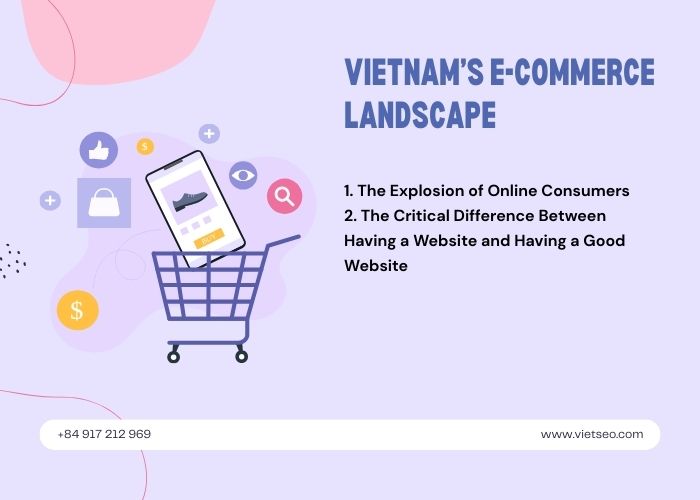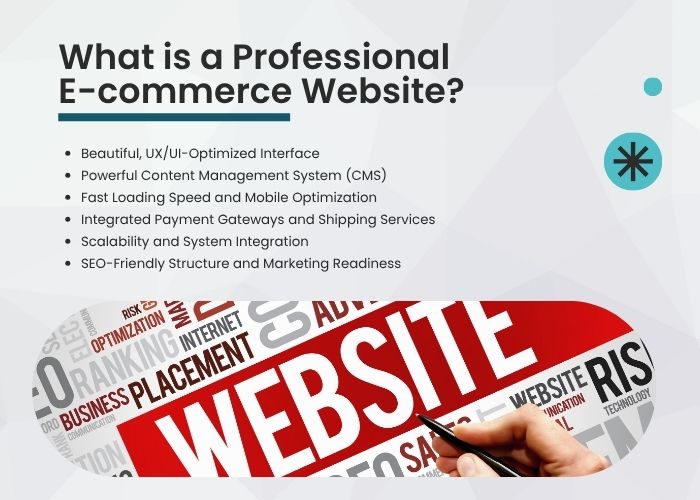Designing a Beautiful and Professionally Tailored E-commerce Website
In today’s e-commerce world, where users can browse thousands of stores with just a few clicks, website interface design is the key factor that determines “love at first sight.” A beautiful e-commerce website not only attracts visitors but also enhances brand value, builds trust, and especially increases conversion rates.
However, “beautiful” is not simply flashy colors or fancy effects. A beautiful website must be a harmonious combination of aesthetic design, user experience (UX), and alignment with industry characteristics. So how do you choose a website template that suits your business sector?
What Is a Beautiful E-commerce Website? “Beauty” From the User’s Perspective
Before selecting a website template, you need to understand: what does “beautiful” mean in e-commerce web design?
Not everything shiny is beautiful
A website with too many effects, inconsistent colors, hard-to-read fonts… may look visually impressive, but actually causes users to feel disoriented and struggle to focus on the product.
Beauty is the balance between:
- Aesthetics: Harmonious colors, high-quality images, clear layout.
- User experience: Easy navigation, smooth interactions, fast loading speed.
- Brand identity: Matches brand positioning and expresses the business’s personality.
- Business goals: Optimizes conversions and guides users to desired actions such as purchasing, booking, or registering.
Why Is Choosing the Right Template for Your Industry So Important?
Every industry has its own characteristics in terms of products, target customers, communication style, and consumer behavior. If you choose a template that doesn’t match, no matter how beautiful it is, it can still create discomfort or reduce sales effectiveness.
Examples:
- A high-end fashion store cannot use the same interface as a motorbike parts shop.
- A spa focused on relaxation and wellness would fail with a template full of bright red colors, cramped layouts, and too many call-to-action buttons.
Website design must “speak the language” of the industry you’re in.
Key Factors to Consider When Choosing a Website Template
1. Color palette and design style
- Fashion, cosmetics: Pastel, black & white, or metallic tones. Favor minimalist layouts, large images, and modern fonts.
- Electronics, tech: Strong tones like blue, gray, black. Prefer layouts with lots of information, product specs, and tech diagrams.
- Food & beverage: Warm colors like brown, orange, light red. Emotion-driven layout, mouth-watering images that stimulate cravings.
2. Target customer behavior
- High-end product buyers prefer minimalist, luxurious websites.
- Discount or budget buyers prefer clear layouts, bold information, and attractive banners.
- B2B customers need information-rich interfaces, with “Documents” or “Catalog” pages.
3. Long-term business goals
Are you planning to expand your product range, or focus on one key product line?
- If selling a wide variety of products → choose a template with a flexible category system.
- If selling a single product line (e.g., handcrafted perfumes, limited-edition watches) → use a landing-page-style template focused on storytelling.
Suggested Website Templates by Industry
Fashion – Accessories – Cosmetics
- Full-screen banner images, image-heavy layouts.
- Built-in lookbooks, soft hover effects.
- Modern fonts, white/black or pastel tones.
- Recommended templates: Flatsome, Astra Fashion, Shopkeeper
Electronics – Technology – Home Appliances
- Grid layout with clearly displayed product specifications.
- Product comparison module, ratings, tech specs.
- Advanced filtering (brand, price, capacity, etc.)
- Recommended templates: Electro, TechMarket, Martfury
F&B – Restaurants – Bakeries – Cafés
- Close-up images, brown/yellow/earthy red color schemes.
- Online menus, booking/reservation, delivery integration.
- Creates a cozy, welcoming feel.
- Recommended templates: Restaurant & Café, Rosa2, Lafka
Spa – Beauty – Yoga – Wellness
- Soft pastel colors, gentle fonts, spacious layout.
- Images of people, relaxing experiences.
- Built-in booking forms, customer testimonials.
- Recommended templates: Avada Spa, Wellness Center, Kallyas
Construction – Interior Design – Architecture
- Minimalist design, lots of white space.
- Project photos, integrated catalog, quotation forms.
- Project showcase section, workflow presentation.
- Recommended templates: Bridge Construction, Architekt, Houzez
Should You Use a Pre-made Template or Hire a Custom Design?
When building an e-commerce site, one of the first decisions you’ll face is whether to use a pre-made template or invest in a custom design. Each option has its pros and cons, and the right choice often depends on your budget, brand identity, and long-term goals. Choosing the right web design service can help you evaluate these options objectively and ensure that your final website balances aesthetics, functionality, and business performance.
Pre-made template:
- Pros: Low cost, quick to deploy, easy basic customization.
- Cons: Not exclusive, might be duplicated, limited deep customization.
→ Suitable for startups, individuals, small shops looking to save time and money.
Custom design:
- Pros: Strong brand identity, exclusive design, optimized experience.
- Cons: Higher cost, longer production time, requires working with a professional team.
→ Suitable for large businesses or high-end brands that view their website as a strategic marketing tool.
Common Mistakes to Avoid When Choosing an E-commerce Template
1. Choosing based on emotion, not business needs
Many people choose templates because they “look nice” or “resemble big brands,” but they don’t suit the product or customer behavior.
2. Heavy design with too many effects
Slows down page load time, especially on mobile. Users leave if they wait more than 3 seconds.
3. Not testing mobile responsiveness
Looks great on desktop but broken layout or hard to use on mobile → lose potential customers.
4. No detailed product pages
Some templates look great visually but lack proper product descriptions, reviews, or pricing tables → reduces trust.
Practical Tips for Applying Templates to E-commerce Sites
- Always test the demo thoroughly: Load it on mobile and tablets, check speed and responsiveness.
- Customize the design to match your brand: Use consistent logos, colors, and fonts.
- Optimize SEO from the start: Make sure the template is SEO-friendly (titles, descriptions, speed, headings...).
- Don’t overlook the policy and blog pages: These are often forgotten but important for both Google and customer trust.
Conclusion
A beautiful e-commerce website isn’t one with flashy effects—it’s a platform that aligns with your target customers, conveys your brand message, and effectively drives conversions.
Choosing a template that fits your industry not only saves time and money but also gives you a strong competitive edge in the eyes of your customers.
Remember: Your website is your online “face” — and first impressions always matter.



